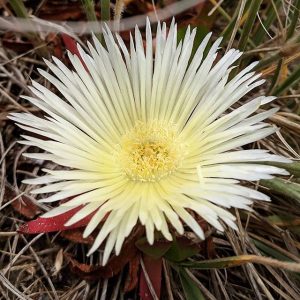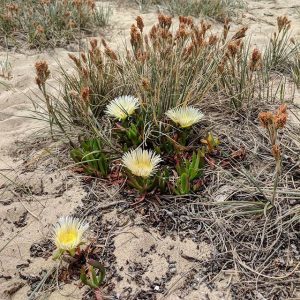Cape Fig or Sour Fig (Carpobrotus edulis), part of the palette of the metropolitan’s fluorescent coast, and another South African import that has transformed urban and bushland landscapes in Victoria. Note that this plant has been widely known as ‘Hottentot Fig’, a derogatory colonial appellation that should be discarded.
Cape Fig can be a highly successful invader of coastal ecologies, producing viable seed but also reestablishing from small and even highly dessicated pieces, and forming dense and vigorous mats to the exclusion of indigenous competitors. Cape Fig also freely hybridises with its native Australian cousins, including Karkalla (C. rossii) across the southern coast and Coastal Pigface (C. virescens) in WA, contaminating the genetics of local native populations wherever it establishes. Photos 1-5 show a colony in grassy dune near Sandringham.
Despite its permanent presence here, the species appears to have been only relatively recently naturalised: although present in gardens on England’s south coast from 1690, Cape Fig does not appear to have been sold by early Melbourne nurseries (except possibly under the generic former epithet Mesembryanthemum), and really only seems to have been recorded naturalised in Victoria from about 1980.
Primarily a weed of coastal environments, the plant also forms credible inland colonies where the situation is suitable (including sandy or rocky strata and an appropriate disturbance regime). Collection records for Victoria include exposed upper bank crests on the Murray River at Mildura, a degraded stony hilltop outside of Colac, and several sites near Cranbourne. To those we can add the exposed rubble railway embankment in Richmond shown in slides 6-10, a low productivity shingle on which C. edulis is extensively established and locally dominant.
View Original Post on Instagram
Search for information about Carpobrotus edulis in the Flora of Victoria
View information and occurrences of Carpobrotus edulis on the Atlas of Living Australia











